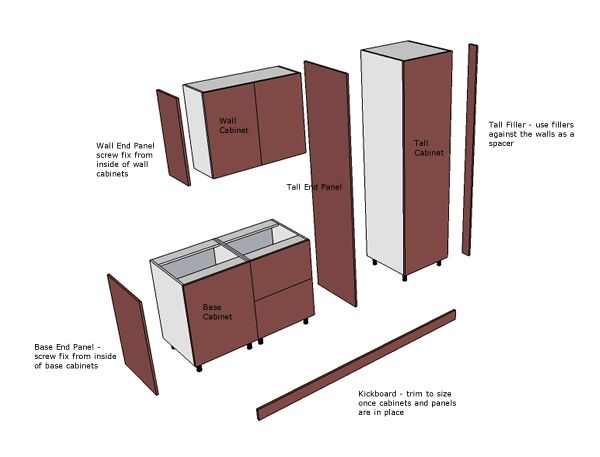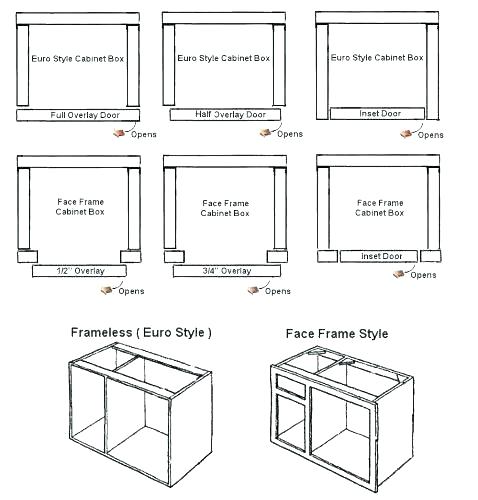Cabinet Basics: Types of Cabinets (Framed vs. Frameless)
With the variety and options of cabinets continually growing on a global scale, it raises the question in every home or business owners mind – so what?
Well, we are incredibly lucky to live in a world that we have the ability to personalize, customize, and provide unique value to everyday things we own including – you guessed it – cabinets! Having a say in what goes into making your house a home is not only empowering, but functional in the fact that it is best suited for you (and your family) and not necessarily anyone else. Now that raises another question to address – what goes into picking a cabinet that is right for me or my business?
Everyday we put on clothes in the morning – we dress ourselves. It’s funny because we essentially do the same thing to every room in our house – we “dress them.” However unlike the daily routine of changing clothes, the cabinets we chose to dress rooms such as kitchens, bathrooms, laundry rooms, mudrooms, and offices are much less often changed. This is why it’s so important to know what, which, and where each individual cabinet will be the most aesthetic and functional based on your personal style.
In order to hone in on your style, let me help you to understand what makes a cabinet, well, a cabinet!
Cabinet Boxes
As the name implies, they are exactly that! These will be the predominant building blocks to which your special room will take shape and implement functionality. Cabinet construction breaks the general term “cabinets” into 3 categories – Base, Wall, and Tall cabinets.
· Base Cabinets are similar to the “socks and shoes” of the room in the sense that they are mounted to the ground and will be the main support for the countertop of your choosing. An easy way to imagine base cabinets is by envisioning a kitchen island without a solid top surface because what’s left is simply the support – a form of base cabinets. They can be a combination of multiple joined together to obtain a fluid and smooth look or can be individually/custom placed in order to fit flush alongside or around appliances.
· Wall Cabinets are – you guessed it – cabinets that get mounted to a wall. These cabinets have no support from the floor and are strictly held by wall mounts. Oftentimes you will see these above countertops and in line with stove hoods as they not only provide a nice visual aesthetic but also a lot of functionality in terms of storage space. Something to consider about wall cabinets are the two height options – fitted to the ceiling (cabinet-moldings-ceiling directly touch) or wall cabinets that do not extend to the ceiling (great for high ceilings, light rails above cabinets, and shorter individuals/families).
· Tall or Pantry Cabinets are essentially just base cabinets that have a drastically increased height (they are “tall”). What is nice about tall cabinets are the options. They can be free-standing and act like an isolated pantry, bathroom storage, or mud/laundry room closets, but also have the ability to be attached to adjacent base cabinets to increase the variety in your kitchen, bathroom, or laundry room. This is a great storage solution to aid the in functionality of the room without compromising organization or the room’s aesthetic perception. Like your favorite childhood “onesie” sleepwear, tall cabinets do the work of both base and wall cabinets combine (but are limited in modification).
The majority of kitchens use a combination of all 3 (placed in endless ways) in order to achieve a unique, yet functional, appearance. Don’t let that limit the possibilities though because you would be amazed at what these 3 cabinet options could do for ANY room – including bathrooms, laundry/mud rooms, and even offices! Think of the amount of ways you could mix and match shoes, pants, and a shirt given you had endless options of each.
Framed and Frameless Construction
Now that the different types of cabinets have been established, it’s time to dig deeper into how you choose your daily outfit. Do you pick a shirt first and then the rest of the outfit after? Or are you more of a person who chooses on the basis of what you will be doing throughout the day? Or maybe you pick a color you like and then find what will work – whatever the case is, it is almost the same for choosing cabinetry.
All cabinet manufacturers vary in their cabinet construction such as materials, thickness, storage space, etc. (stay tuned for the weeks upcoming Cabinets basics – Cabinet Construction article), however, all manufacturers follow two basic design styles; Framed and Frameless.
Framed Cabinets, like much of the other vocabulary in the industry, are what they sound like. Also known as the “American Style” of cabinet construction, they are constructed so that a wooden (or whatever material type you have decided upon) frame is fitted around the outer edge of the face of the cabinets. This face frame provides rigidity to the box and also extends slightly past the inside edge of the front frame. It not only assists the cabinet in remaining square and durable, but also adds cohesively to the design by providing a background that emphasizes the cabinet face and detail. In my analogy of getting dressed in the morning, this would be similar to wearing a shirt under a casual button-up shirt. And almost like choosing how many buttons to button on that shirt (if any), framed cabinets have multiple options to either hide or show the face frame:
Frameless Cabinets, contrary to framed cabinets, lack the frontal face frame and tend to offer a bit more accessibility and storage as compared to the other style. Also, this type of cabinet construction has been deemed as “European Style” due to the minimalist and simple design. The lack of an inside perimeter as seen with framed cabinets, provides up to 16% more storage space and allows drawer boxes to be larger for a given cabinet size (because it does not need to fit within a frame). The most common styles of cabinet doors used for this are full-overlay and full-inset.
o Full-Overlay means that the cabinet doors and drawer faces completely cover the face frame. Think of buttoning up your shirt all the way so that the under-shirt isn’t visible.
o Partial-Overlay is the most common with framed cabinets and usually takes on the style of 1/2” or 3/4” partial overlay, meaning 1/2” or 3/4” of the face frame is covered with the remainder of the frame (width) being exposed. This is like leaving the top 2-3 buttons undone on your shirt – some of your undershirt is sure to be seen.
o Full-Inset is the most popular among expensive trends and high-end design due to the drawers and cabinet doors fitting within the face frame. It provides a seamless and smooth appearance from cabinet to cabinet. This is like picking the perfect undershirt that accentuates your fully unbuttoned, button-up shirt. It should be noted however, that the wood expands and contracts based on the seasonal weather and this style requires more maintenance than the ones mentioned prior.
The unique thing about both framed and frameless cabinets is the possibility for customization given the right cabinet company. For example, for framed or frameless cabinets that only provide the option of cabinet door overlay rather than inset (which is the case for many cabinetry companies), on-site modifications can be made to give the doors an inset look without the inset price or maintenance. This can be done by utilizing finished panels between the door faces to create the flush and seamless look so often desired. Other alternative solutions that add extra detail while filling in the cabinet face frame are column posts. As mentioned, it is important to choose the right cabinet company (such as UR Cabinets) that will explore any and all alternatives and options prior to making a definitive decision!
Although each has their own name and can be associated with their “Pros and Cons,” don’t let your patriotism get the best of you because both the American-style framed and European-style frameless offer their own unique benefits and unique visual appeal. The reasoning for the two very different cabinet construction types was the origin of design and manufacturing. Neither have a definitive advantage, making the options for the average home owner even greater. It really just comes down to how you would want to go about dressing your room.











